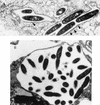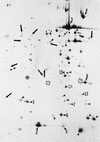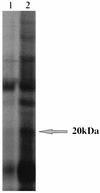Induced expression of the Legionella pneumophila gene encoding a 20-kilodalton protein during intracellular infection
- PMID: 9423859
- PMCID: PMC107878
- DOI: 10.1128/IAI.66.1.203-212.1998
Induced expression of the Legionella pneumophila gene encoding a 20-kilodalton protein during intracellular infection
Abstract
The eukaryotic protein synthesis inhibitor cycloheximid has been used by many investigators to selectively radiolabel intracellular bacteria. Although cycloheximide has no direct effect on bacterial gene expression, there are concerns that long-term inhibition of the host cell protein synthesis may have secondary effects on bacterial gene expression. Therefore, prior to further identification and cloning of the macrophage-induced (MI) genes of Legionella pneumophila, the effects of cycloheximide on L. pneumophila-infected U937 cells were evaluated by transmission electron microscopy. Inhibition of protein synthesis of the host cell for 6 h had no major effect on the ultrastructure of the host cell, on the formation of rough endoplasmic reticulum-surrounded replicative phagosome, or on initiation of intracellular bacterial replication. In contrast, by 15 h of cycloheximide treatment, there was profound deterioration in the host cell as well as in the phagosome. To examine protein synthesis by L. pneumophila during the intracellular infection, U937 macrophage-like cells were infected with L. pneumophila, and intracellular bacteria were radiolabeled during a 2-h cycloheximide treatment or following 12 h of cycloheximide treatment. Comparison by two-dimensional sodium dodecyl sulfate-polyacrylamide gel electrophoresis of the protein profile of radiolabeled in vitro-grown L. pneumophila to that of intracellularly radiolabeled bacteria showed that 23 proteins were induced in response to the intracellular environment during 2 h of inhibition of host cell protein biosynthesis. Twelve MI proteins of L. pneumophila were artifactually induced due to prolonged inhibition of the host cell protein synthesis. The gene encoding a 20-kDa MI protein was cloned by a reverse genetics technique. Sequence analysis showed that the cloned gene encoded a protein that was 80% similar to the enzyme inorganic pyrophosphatase. Studies of promoter fusion to a promoterless lacZ gene showed that compared to in vitro-grown bacteria, expression of the pyrophosphatase gene (ppa) was induced fourfold throughout the intracellular infection. There was no detectable induction in transcription of the ppa promoter during exposure to stress stimuli in vitro. The ppa gene of L. pneumophila is the first example of a regulated ppa gene which is selectively induced during intracellular infection and which may reflect enhanced capabilities of macromolecular biosynthesis by intracellular L. pneumophila. The data indicate caution in the long-term use of inhibition of host cell protein synthesis to selectively examine gene expression by intracellular bacteria.
Figures









Similar articles
-
Transcriptional regulation of the macrophage-induced gene (gspA) of Legionella pneumophila and phenotypic characterization of a null mutant.Mol Microbiol. 1997 May;24(3):629-42. doi: 10.1046/j.1365-2958.1997.3661739.x. Mol Microbiol. 1997. PMID: 9179855
-
Heterogeneity in the attachment and uptake mechanisms of the Legionnaires' disease bacterium, Legionella pneumophila, by protozoan hosts.Appl Environ Microbiol. 1998 Jan;64(1):126-32. doi: 10.1128/AEM.64.1.126-132.1998. Appl Environ Microbiol. 1998. PMID: 9435069 Free PMC article.
-
The Legionella pneumophila icm locus: a set of genes required for intracellular multiplication in human macrophages.Mol Microbiol. 1994 Nov;14(4):797-808. doi: 10.1111/j.1365-2958.1994.tb01316.x. Mol Microbiol. 1994. PMID: 7891565
-
The road less traveled: transport of Legionella to the endoplasmic reticulum.J Cell Biol. 2002 Aug 5;158(3):415-9. doi: 10.1083/jcb.200205011. Epub 2002 Jul 29. J Cell Biol. 2002. PMID: 12147677 Free PMC article. Review.
-
[Intracellular survival and replication of legionella pneumophila within host cells].Yakugaku Zasshi. 2008 Dec;128(12):1763-70. doi: 10.1248/yakushi.128.1763. Yakugaku Zasshi. 2008. PMID: 19043295 Review. Japanese.
Cited by
-
Analysis of stress- and host cell-induced expression of the Mycobacterium tuberculosis inorganic pyrophosphatase.BMC Microbiol. 2001;1:3. doi: 10.1186/1471-2180-1-3. Epub 2001 Apr 24. BMC Microbiol. 2001. PMID: 11339880 Free PMC article.
-
Proteomic and systems biology analysis of the monocyte response to Coxiella burnetii infection.PLoS One. 2013 Aug 21;8(8):e69558. doi: 10.1371/journal.pone.0069558. eCollection 2013. PLoS One. 2013. PMID: 23990884 Free PMC article.
-
Signal transduction in the protozoan host Hartmannella vermiformis upon attachment and invasion by Legionella micdadei.Appl Environ Microbiol. 1998 Sep;64(9):3134-9. doi: 10.1128/AEM.64.9.3134-3139.1998. Appl Environ Microbiol. 1998. PMID: 9726850 Free PMC article.
-
Identification of macrophage-specific infectivity loci (mil) of Legionella pneumophila that are not required for infectivity of protozoa.Infect Immun. 1998 Mar;66(3):883-92. doi: 10.1128/IAI.66.3.883-892.1998. Infect Immun. 1998. PMID: 9488371 Free PMC article.
-
Temporal pore formation-mediated egress from macrophages and alveolar epithelial cells by Legionella pneumophila.Infect Immun. 2000 Nov;68(11):6431-40. doi: 10.1128/IAI.68.11.6431-6440.2000. Infect Immun. 2000. PMID: 11035756 Free PMC article.
References
-
- Abu Kwaik Y, Engleberg N C. Cloning and molecular characterization of a Legionella pneumophila gene induced by intracellular infection and by various in vitro stress stimuli. Mol Microbiol. 1994;13:243–251. - PubMed
Publication types
MeSH terms
Substances
Associated data
- Actions
Grants and funding
LinkOut - more resources
Full Text Sources
Other Literature Sources
Medical

